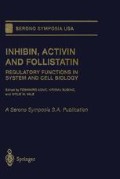Abstract
During vertebrate gastrulation, the cells of the dorsal ectoderm give rise to the central nervous system; ventral ectoderm differentiates into epidermis. In amphibians, the neuralization of the dorsal ectoderm is mediated by signals from the dorsal lip of the blastopore (Spemann’s organizer). An ectopic dorsal lip will neuralize ventral ectoderm (1). Ectodermal expiants (or “animal cap” expiants), cultured alone, will form only epidermis; recombined with a dorsal lip, these expiants form neural tissue (2). The recognition that the dorsal lip was both necessary and sufficient for neural induction implied that the organizer was the source of a soluble, neural-inducing factor that could neuralize ectoderm in a direct, noncell autonomous manner; signals from the organizer provide an instructive signal to the ectoderm to form neural tissue. Thus, for decades, the consensus view was that epidermis was the “default” state of the ectoderm.
Access this chapter
Tax calculation will be finalised at checkout
Purchases are for personal use only
Preview
Unable to display preview. Download preview PDF.
References
Spemann H, Mangold H. Über Induktion von Embryonanlagen dürch Implantation artfremder Organisatoren. Arch Mikrosk Anat Entwicklungsmech 1924;100:599–638.
Holtfreter J. Regionale Induktionen in Xenoplastisch Zusammengesetzten Explantaten. Roux’Arch Entwicklungsmech 1936;134:466–550.
Grunz H, Tacke L. Neural differentiation of Xenopus laevis ectoderm takes place after disaggregation and delayed reaggregation without inducer. Cell Differ Dev 1989;28:211–8.
Sato SM, Sargent TM. Development of neural inducing capacity in dissociated Xenopus embryos. Dev Biol 1989;134:263–6.
Godsave SF, Slack JMW. Clonal analysis of mesoderm induction in Xenopus laevis. Dev Biol 1989;134:486–90.
Hemmati-Brivanlou A, Melton DA. A truncated activin receptor dominantly inhibits mesoderm induction and formation of axial structures in Xenopus embryos. Nature (Lond) 1992;359:609–14.
Hemmati-Brivanlou A, Melton DA. Inhibition of activin receptor signaling promotes neuralization in Xenopus. Cell 1994;77:273–81.
Fainsod A, Steinbeisser H, DeRobertis EM. On the function of BMP-4 in patterning the marginal zone of the Xenopus embryo. EMBO J 1994;13:5015–25.
Hemmati-Brivanlou A, Thomsen GA. Ventral mesodermal patterning in Xenopus embryos: expression patterns and activities of BMP-2 and BMP-4. Dev Genet 1995;17:78–89.
Wilson PA, Hemmati-Brivanlou A. Induction of epidermis and inhibition of neural fate by Bmp-4. Nature (Lond) 1995;376:331–3.
Sasai Y, Lu B, Steinbeisser H, DeRobertis EM. Regulation of neural induction by the Chd and BMP-4 antagonistic patterning signals in Xenopus. Nature (Lond) 1995;376:333–6.
Hawley SHB, Wunnenberg-Stapleton K, Hashimoto C, Laurent MN, Watabe T, Blumberg BW, Cho KWY. Disruption of BMP signals in embryonic Xenopus ectoderm leads to direct neural induction. Genes Dev 1995;9:2923–35.
Xu RH, Kim J, Taira M, Zhan S, Sredni D, Kung HF. A dominant negative bone morphogenetic protein 4 receptor causes neuralization in Xenopus ectoderm. Biochem Biophys Res Commun 1995;212:212–9.
Suzuki A, Shioda N, Ueno N. Bone morphogenetic protein acts as a ventral mesoderm modifier in early Xenopus embryos. Dev Growth Differ 1995;37:581–8.
Lamb TM, Knecht AK, Smith WC, Stachel SE, Economides AN, Stahl N, Yancopolous GD, Harland RM. Neural induction by the secreted polypeptide noggin. Science 1993;262:713–8.
Hemmati-Brivanlou A, Kelly OG, Melton DA. Follistain, an antagonist of activin, is expressed in the Spemann organizer and displays direct neuralizing activity. Cell 1994;77:283–95.
Smith WC, Harland RM. Expression cloning of noggin, a new dorsalizing factor localized to the Spemann organizer in Xenopus embryos. Cell 1992;70:829–40.
Sasai Y, Lu B, Steinbeisser H, Geissert D, Gont LK, DeRobertis EM. Xenopus chordin: a novel dorsalizing factor activated by organizer-specific homeobox genes. Cell 1994;79:779–90.
Francois V, Bier E. Xenopus chordin and Drosophila sog genes encode homologous proteins functioning in dorsal-ventral axis formation. Cell 1995;80:19–20.
Zimmerman LB, De Jesus-Escobar JM, Harland RM. The Spemann organizer signal noggin binds and inactivates bone morphogenetic protein 4. Cell 1996;86:599–606.
Piccolo S, Sasai Y, Lu B, DeRobertis EM. Dorsoventral patterning in Xenopus: inhibition of ventral signals by direct binding of chordin to BMP-4. Cell 1996;86:589–98.
Yamashita H, Ten Dijke P, Huylebroeck D, Sampath TK, Andries M, Smith JC, Heldin C-H, Miyazono K. Osteogenic protein-1 binds to activin type II receptors and induces certain activin-like effects. J Biol Chem 1995;130:217–26.
Editor information
Editors and Affiliations
Rights and permissions
Copyright information
© 1997 Springer Science+Business Media New York
About this chapter
Cite this chapter
Weinstein, D., Chang, C., Lagna, G., Suzuki, A., Wilson, P., Hemmati-Brivanlou, A. (1997). Neural Induction in the Frog Xenopus laevis . In: Aono, T., Sugino, H., Vale, W.W. (eds) Inhibin, Activin and Follistatin. Serono Symposia USA. Springer, New York, NY. https://doi.org/10.1007/978-1-4612-1874-6_21
Download citation
DOI: https://doi.org/10.1007/978-1-4612-1874-6_21
Publisher Name: Springer, New York, NY
Print ISBN: 978-1-4612-7320-2
Online ISBN: 978-1-4612-1874-6
eBook Packages: Springer Book Archive

